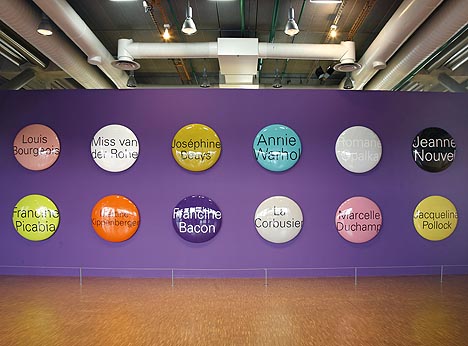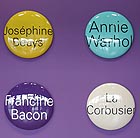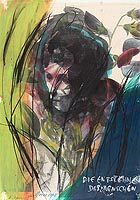
translated and summarized by: Liz Wollner-Grandville,
English summary November 1 - 8
Centre Pompidou: elles@centrepompidou
Ladies first
Jacqueline Pollock, Joséphine Beuys, La Corbusier or Miss van der Rohe: how would art have developed if its key figures were women? Would they have experienced the blessings of art history? Visitors to the newly conceptualized collection rooms of the Centree Pompidou in Paris are accompanied by the Agnès Thurnauer’s installation in which the French artist mounted the names of celebrities onto oversized, colourful buttons: for the duration of 15 months an entire floor was emptied to present works which were exclusively created by female artists from the Centre’s own collection. The remarkable exhibition elles@centrepompidou displays 500 works composed by more than contemporary 200 artists - ranging from the 20th century to the present day - presented in a chronological as well as thematic structure – a vibrating conglomerate of the most diverging artistic forms of expression, a colourful gallimaufry of interests and positions.
As praiseworthy as it may be to offer female artists so much space, one cannot avoid the impression that these artists primarily create art that is typically feminine – not a very contemporary variant. This impression is supported by the way the works are hung – already at the beginning of the tour the art focuses on feminine actionist art. Nikki de Saint Phalle’s painting from 1961 clearly presents the violent intrusion into the male domain of Action Painting and Orlan’s performances “MesuRages” (1970’s) showing her body in a humiliating posture crawling through exhibition halls and streets, which were all named in memory of famous males, the social barriers and constraints which female artists were and still are exposed to, become visible. Through the newly emerging media: video and photography, the artists succeeded in conquering an experimental playfield – again, paradoxically, by staging naked female bodies, however this time in the form of self-reflection and liberated of conformity.
On the one hand, the numerous key works of feminist art are testimony of the Centre Pompidou’s far-reaching strategy, and sensitise the onlooker, but on the other hand, the strength of the works turns out to be as the weakness of the exhibition concept, because the quiet tones - set beyond the feminist – are threatened to be overheard. Already in 1975, Meret Oppenheim wrote an article titled “Female art does not exist”. But an exhibition such as this one strengthens the perception of female art as a particularity; one that is worthy of being presented as a special exhibition. elles@centrepompidou offers the viewer surprising comparisons. Large-format city photographs by the Japanese artist Mariko Mori contrast Dorothea Tanning’s nightmarish-disturbing installation, while the reluctant narrations by Sophie Calle allow intimate insights into emotional worlds.
The stunning ironic video “Me, 1997 – 2000”, by the Iranian artist Ghazel, gives proof of the remarkable actuality of feminist topics even today. Between tragedy and humour, a woman dressed in a chador demonstrates her inner conflict between the cultures and the desirable goals. She fulfils her dream of travelling around the world by walking around a globe, and the pleasure that her inconvenient garment doesn’t prevent her from skiing, immediately shifts into a feeling of amusement linked with horror when two machineguns tumble into the snow as she falls. While the creation of female art is a matter of course in today’s Western hemisphere, the achievements of earlier generations are not valued in all parts of the world. But one has to keep the following in mind: a report published in 2006 by the “Department for Cultural Affairs of the City of Berne” together with the “Department for the equality of Men and Women in the City of Berne” uncovered that only 27 percent of the subsidies in the field of applied arts between 1994 and 2003 were granted to women. This fact desperately calls for the yelling of the Guerilla Girls. In 1988, this anonymous activist group, disguised with gorilla masks, created a poster with the words: “The advantages of being a woman artist: working without the pressure of success”.
By Sylvia Mutti
Centre Pompidou
75191 Paris, Paris cedex 04, until 24.05.10
www.centrepompidou.fr
Galerie ArtPoint / KulturKontakt Austria: Here, There & In-between – 20th anniversary of KulturKontakt Austria
Into the future at idle speed
1989 – the revolution in Central and Eastern Europe. Changes of epochs are not always liberating times. They introduce phases of insecurity, even chaos. Change of scene: the decision to found KulturKontakt Austria is made in the same year, demonstrating responsibility as a neighbouring country and offering foresight and spirit. Pragmatically, the most important model of cooperation is the European unification project. Cultural heritage shapes and secures the future.
The simple, yet very expressive exhibition “Here, There & In-between – 20th anniversary of KulturKontakt Austria” goes back into a world in which the cartography of the Cold War was still intact. Large parts of Eurasia and the former Eastern Block countries still bear the communist star, but the political system was already running at idle speed.
These historic changes of 1989 are presented in a humoristic, factual as well as in a sad way. In a video, an alcoholic demands: “we need a program”. The figures in a Play Mobil dollhouse represent the features of a civil society: “tolerance, society, family, and individual”.
To which extent the allegories and symbols of Communism were depleted is clearly shown by KulturKontakt’s history. Individual people, projects and even country cooperations were supported by its consequent mediation of culture, art, and sponsoring.
The exhibition is based on a conglomeration of documents, publications, artwork, presents and leftovers of the work of the past 20 years. The “Evil Girls” by Ana Nedelijkovic present the negative sides of young democratic systems with a tragic-funny honesty. The civil wars in former Yugoslavia, economic corruption or bloody, short-term insurrections constitute the background of the exhibition. The installation “Invitation to a piece of cake…”, showing 800 yellow and red pieces of cake by the Hungarian Ilona Nemeth, points to the most important reason for the continuance of KulturKontakt - a forgiving, inviting factor in the mediation and conciliation between the cultures, which has been the institution’s success factor for many years.
By Alexander Lass
Galerie ArtPoint / KulturKontakt Austria
1010 Vienna, Universitätsstrasse 5, until 27.11.09
www.kulturkontakt.or.at
Brot Kunsthalle: The Promise of Loss – A Contemporary Index of Iran
Not time to fool around
Since the beginning of this millennium, the European and US art industry increasingly focused on global events. A pleasing side effect is that institutions and galleries gather experience in shaping respective exhibitions. While the “Art from…” projects of the 1990’s seemed to be organized in a rather helpless and arbitrary way, it is clear today that a reasonably plausible exhibition needs, beyond its national affinity, an additional curatorial perception.
Gallery owner Ernst Hilger was successful in doing so at the first exhibition of the newly opened Brot Kunsthalle: “The Promise of Loss”, curated by Shaheen Merali, combines Iranian art with an obvious society critical relevance. A large part of the works target the essentialities: women in chadors stand at a gloomy burial site (Amin Nourani), blood-red water bubbles out of a fountain (Mandana Moghaddam), women, stoned and shackled, are transformed into ornaments (Parastou Forouhar), stories narrating political murders are depicted on stamps (Jinoos Taghizadeh), hand grenades are lined up in a refrigerator or on a breakfast table (Shadi Ghadirian).
Many of the works are bold, many are short of being kitschy or go beyond being kitschy – drawings of women wearing scarves exercising sports associated to males (Behrang Samadzadegan) are a rarity. The directness with which criticism is articulated can easily shift into too much simplicity, but this phenomenon is an exception. What remains, is an unmistakably articulate, committed and in many parts even artistically interesting, statement on the situation in Iran. There is no time to fool around here.
By Nina Schedlmayer
Brot Kunsthalle
1100 Vienna, Absbergg. 27, until 30.11.09
www.brotkunsthalle.com
Albertina: Brus & Rainer – On the Horizon of the Senses
The art of transforming a lion into a unicorn
This time the initiator also functioned as the transmitter, travelled to Tenerife, packed the half-finished compilation into a suitcase and brought it to Austria for further processing, both artists then met to sign their joint oeuvre. Arnulf Rainer and Günter Brus collaborated in this way in 1984 and their cooperation was presented on the occasion of the opening of Heike Curtze’s new gallery rooms in a downtown Vienna palace. At that time, the press reminded of the earlier cooperation between Rainer with Roth and Brus with Attersee and bitched that one could not be so sure if these elective affinities would not turn into agonized affinities….
In any case, everything worked out fine, and the result of this joint venture is currently displayed at the Albertina.
There was once a white, which was maculated by an artist and a painting-poet, Brus says on one of the pieces and thereby reveals the firm sequence of their cooperation. Rainer, through his self-induced inability to paint on a white sheet of paper, created photographed master illustrations - with the help of laser copies - as primers, whose sizes were limited to A3, and added scarce (brush) strokes onto them. In turn, Brus, the painting-poet, commented with sketches and drawings – at times lyrically, in an art historical context or with a wordplay.
Accordingly, these ideas come across as somewhat caustic. But when proud lions turn into shy unicorns, and a painting, comprising a few lines, titled “A soporific is taken by itself”, - one is inspired to ask if a late work exists based on the principle of “cooperation”.
By Daniela Gregori
Albertina
1010 Vienna, Albertinaplatz 1, until 31.01.10
www.albertina.at
Mehr Texte von translated and summarized by: Liz Wollner-Grandville


 Teilen
Teilen





